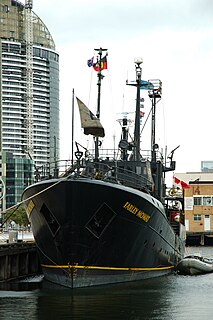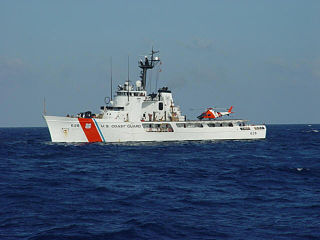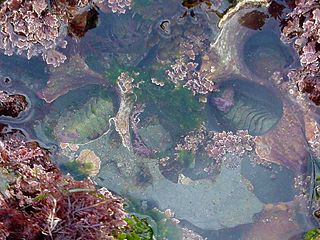Lifeline or Lifelines may refer to:

RV Farley Mowat was a long-range, ice class ship. Originally built as a Norwegian fisheries research and enforcement vessel, she was purchased by the Sea Shepherd Conservation Society in Edinburgh, Scotland, in August 1996. She is named after Canadian writer Farley Mowat. Her previous name with the group was Ocean Warrior.

The NOAA Ship Delaware II is a National Oceanic and Atmospheric Administration (NOAA) fisheries research vessel that was in commission from 1970 to 2012. Prior to her NOAA career, she was in commission in the United States Fish and Wildlife Service's Bureau of Commercial Fisheries from 1968 to 1970 as BCF Delaware II.
The United States Coast Guard carries out three basic roles, which are further subdivided into eleven statutory missions. The three roles are:

USCGC Confidence (WMEC-619) is a United States Coast Guard medium endurance cutter.

USCGC Venturous (WMEC-625) is a United States Coast Guard medium endurance cutter.

RV Cefas Endeavour is an ocean-going fisheries research vessel based at the port of Lowestoft and owned by the Centre for Environment, Fisheries and Aquaculture Science (Cefas). She is used to support all aspects of Cefas activities from fish stock surveys to launching autonomous monitoring equipment. The ship was built to replace the former research vessel RV Cirolana, and was designed to minimise underwater noise, and therefore disturbance of fish - ensuring better results from sonar equipment. Operation is currently outsourced by Cefas to P&O Maritime Services.

USNS Trenton (T-EPF-5),, (ex-Resolute) is a Spearhead-class expeditionary fast transport vessel. Spearhead-class ships are used to support overseas operations, conduct humanitarian aid and disaster relief, and support special operations forces. This type of vessel also has an aviation flight deck and can operate in shallow waters. Trenton completed acceptance trials on 13 March 2015 and was delivered to the United States Navy on 13 April 2015.
The Migrant Offshore Aid Station (MOAS) is an international humanitarian organisation based in Malta dedicated to providing aid and emergency medical relief to refugees and migrants around the world.
Marine Research Vessel (MRV) Alba-Na-Mara is a small fisheries research vessel, operated by Marine Scotland on behalf of the Scottish Government.
The Phoenix is a ship built by Davie Shipbuilding in Lévis, Quebec and launched as the trawler GC Bassin in 1973. Since then, her roles have included a research vessel and a training ship, before her current use by the Migrant Offshore Aid Station as a rescue vessel, rescuing people in distress at the Mediterranean Sea.

Proactiva Open Arms is a Spanish NGO devoted to search and rescue (SAR) at sea. Set up in October 2015, it carried out its first rescue action that same month from its base on the Greek island of Lesbos.

The MV Aquarius Dignitus, formerly Aquarius 2 and Aquarius, is a 1977-built dual-flagged search and rescue vessel, which has been used to rescue refugees and illegal migrants stranded in the Mediterranean sea since 2016. It has been chartered and operated since February 2016 by the NGOs SOS Méditerranée and Médecins Sans Frontières as a rescue vessel for migrants and refugees making the Mediterranean crossing in makeshift craft from Libya to Italy as part of the European migrant crisis.
SOS Méditerranée is a European, maritime-humanitarian organisation for the rescue of life at sea, currently operating in the Mediterranean sea in international waters north of Libya. The organization charteres the Aquarius in order to rescue people fleeing by sea from Libya and who risk drowning. The group was founded in June 2015 by German former captain Klaus Vogel and Frenchwoman Sophie Beau after the Italian navy ended the rescue operation Mare Nostrum in 2014. Its headquarters are based in Marseille, France.
Jugend Rettet is a Non-governmental organization (NGO) from Berlin. Its goal is to save drowning persons at the Mediterranean. Operations are conducted with the Iuventa, a ship that sails under Dutch flag. This ship was seized in August 2017 after suspicion of cooperation with migrant smugglers.

RV George Bligh (LO309) was a fisheries research vessel that was operated by the Directorate of Fisheries, now known as the Centre for Environment, Fisheries and Aquaculture Science (Cefas).

NOAAS Oregon, previously NOAAS Oregon, was an American fisheries research vessel in commission in the National Oceanic and Atmospheric Administration (NOAA) fleet from 1970 to 1980. Prior to her NOAA career, she operated under the United States Fish and Wildlife Service from 1949 to 1970 as R/V Oregon.

NOAAS Murre II, previously NOAAS Murre II, was an American research vessel in commission in the National Oceanic and Atmospheric Administration (NOAA) fleet from 1970 to 1989. Prior to her NOAA career, she operated under the United States Fish and Wildlife Service′s Bureau of Commercial Fisheries from 1949 to 1970 as Murre II.























